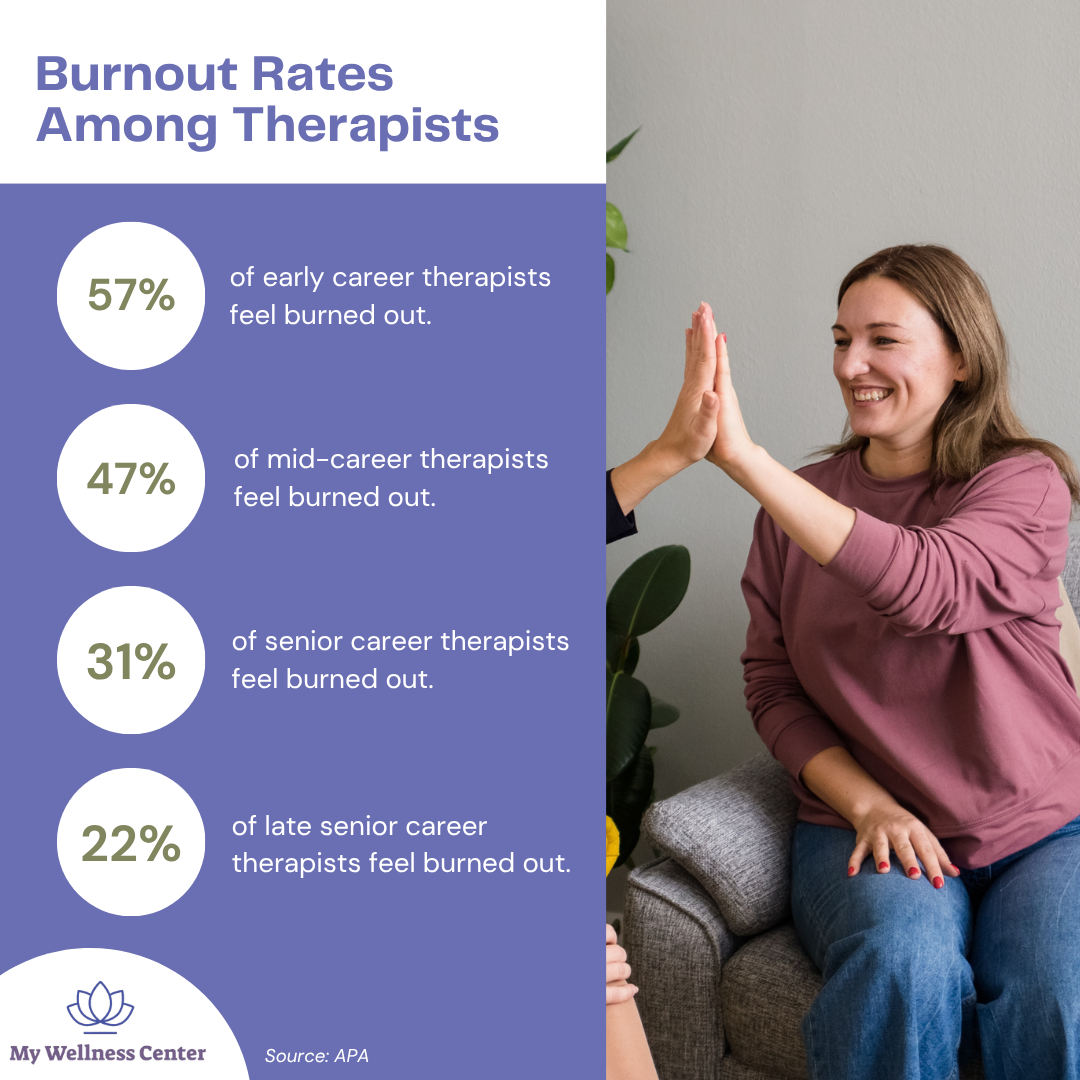It may sound counterintuitive, but therapy for therapists is critical—for both therapists and their clients.
As mental health professionals, we spend our days navigating the stressful, emotional trials of other people’s lives (while simultaneously balancing our own struggles).
That’s challenging.
And it doesn’t always get easier with experience.
Even after spending years as a therapist and building the My Wellness Center team, I know I’m going to experience burnout symptoms every three months. If I don’t plan accordingly (by scheduling a couple of days off, taking a small trip, or booking some self-care), my business and home life suffer.
Therapist burnout is real. And if you don’t take care of yourself, you’ll suffer from burnout as well—which could then negatively impact your patients.
Table of Contents
What Is Therapist Burnout?
Burnout Rates And Mental Health Among Therapists
How to Overcome Burnout In Therapists
Find A Pittsburgh Therapist
Final Thoughts On Therapist Burnotut
What Is Therapist Burnout?
Therapist burnout is a state of emotional, physical, and mental exhaustion that occurs when a therapist feels overwhelmed by the chronic stress of their work. It’s more than just a bad week—it’s a sustained feeling of depletion, reduced motivation, and even detachment from clients.
Unlike standard workplace burnout, therapist burnout often stems from the unique emotional demands of the profession. Potential contributing factors include:
- compassion fatigue
- vicarious trauma
- administrative overload
- blurred boundaries
None of these are easy to navigate. Over time, these factors can erode your sense of purpose and leave you feeling ineffective, isolated, or even cynical about your work.
Therapist burnout symptoms may include:
- emotional numbness or irritability
- dread before sessions
- difficulty concentrating or being present
- increased physical fatigue or illness
- depersonalization or feeling disconnected from clients
- questioning your competence or career path
As you know, these can have long-standing consequences. If left unaddressed, burnout can impact the quality of care therapists provide—and their own overall well-being.
Burnout Rates And Mental Health Among Therapists
Everyone is susceptible to burnout, no matter your experience level, background, or education.
Research shows stress levels are highest among early-career therapists, and they tend to decrease with age. On a scale of 1-10 (with 10 being the worst), here’s how therapists rate their own stress levels, according to the APA:
- Early Career: 6.5/10
- Mid-Career: 6.4/10
- Senior Career: 5.7/10
- Late Senior Career: 5.3/10
While those numbers may not feel alarming by themselves, the proportion of professionals who report burnout is alarming. Here’s how that breaks down:
- Early Career: 57.3% of therapists feel burned out
- Mid-Career: 46.7% feel burned out
- Senior Career: 30.9% feel burned out
- Late Senior Career: 22.2% feel burned out

How to Overcome Burnout In Therapists
Recovering from burnout doesn’t happen overnight, but it is absolutely possible with the right strategies and support. Here are some of the most effective ways therapists can begin to heal:
1. Acknowledge It Without Shame
Burnout is common (as the research demonstrates), and being burned out doesn’t make you a bad therapist. The first step is recognizing the signs and giving yourself permission to take your own mental health seriously.
2. Reconnect With Your Why
What drew you to therapy in the first place? Take time to revisit the purpose behind your practice. Reflecting on the clients you’ve helped or the values that guide your work can reignite your internal motivation.
3. Set (and Enforce) Boundaries
Burnout often stems from blurred or nonexistent boundaries. That might mean reducing your caseload, ending sessions on time, not answering emails after hours, or creating buffer time between clients.
Your mental health matters, so set boundaries accordingly.
4. Seek Therapy Yourself
Therapists need therapy, too. Working with your own clinician can give you space to process, reflect, and heal. Whether it’s EMDR, ACT, IFS, or simple talk therapy, having that outlet is vital.
5. Find Peer Support
Join a consultation group or connect with other clinicians. Sometimes, the best way to reduce burnout is to simply talk to someone who gets it. Peer support reminds you you’re not alone.
Explore opportunities like My Wellness Retreats to find like-minded professionals ready to grow and connect.
6. Streamline Admin Tasks
Therapists often spend just as much time on paperwork, billing, and insurance as they do with clients. Consider hiring a virtual assistant, using practice management software, or outsourcing billing to reclaim your time and energy.
7. Make Space for Joy Outside of Work
You are more than your profession. Carve out time for hobbies, friendships, movement, rest, and creativity—without guilt. Joy isn’t a luxury. It’s a necessity.
Find A Pittsburgh Therapist
At My Wellness Center, we believe in therapy for therapists. We’ve built a team of compassionate therapists who are ready to lend a helping hand, either through sessions or group supervision.
Contact us to learn more—and to overcome burnout.
Final Thoughts On Therapist Burnout
Stress among therapists is all too common, with some studies showing 52% of therapists have suffered from burnout in the last 12 months. Left unaddressed, burnout can negatively impact client outcomes and the rest of a therapist’s life.
But by attending therapy, practicing self-care, and optimizing one’s professional practice, therapists can overcome their own mental health challenges.

